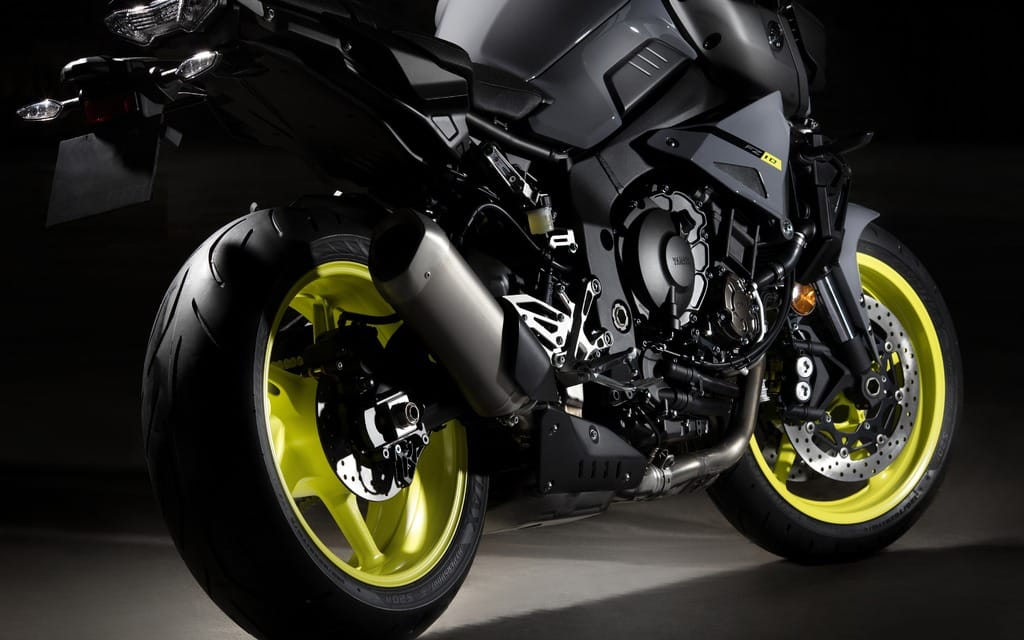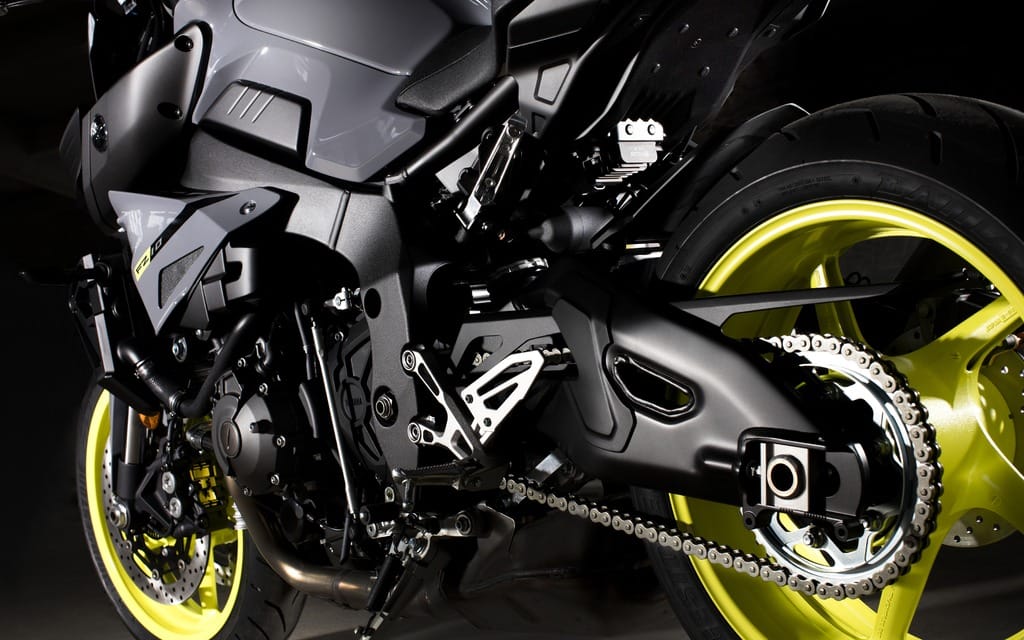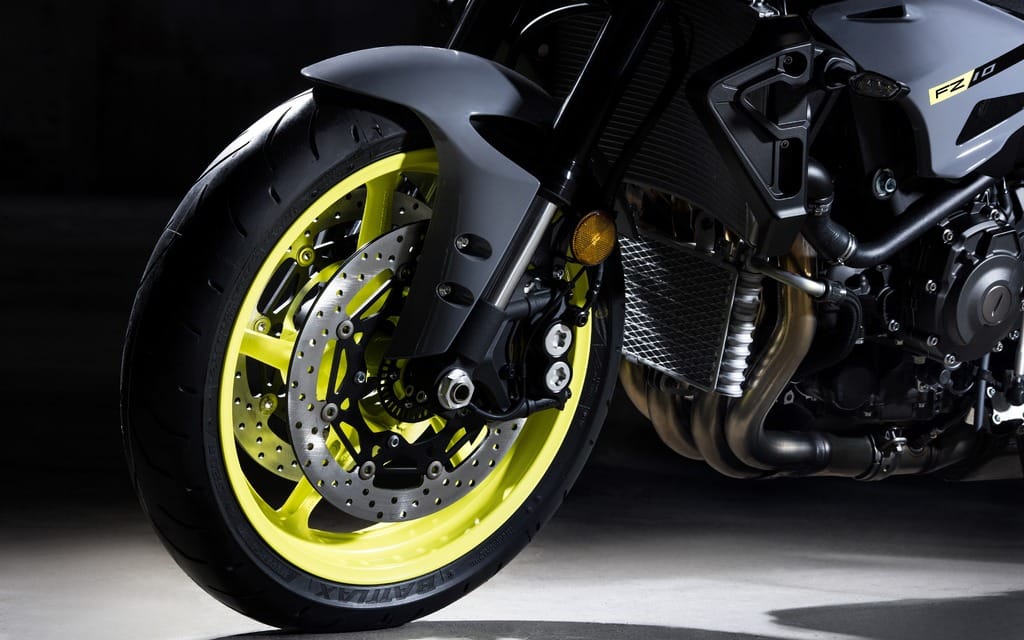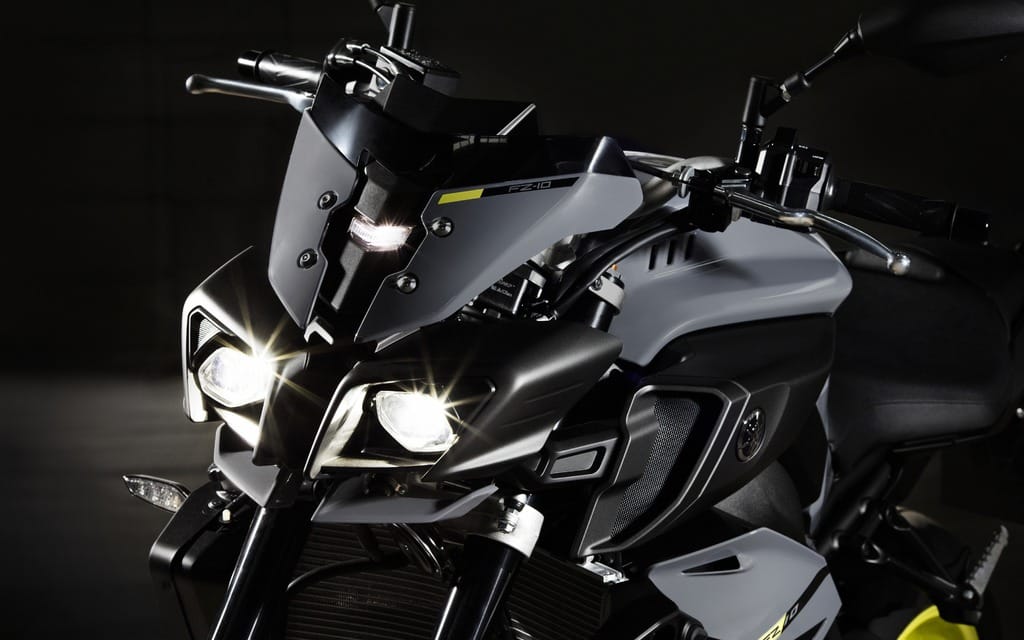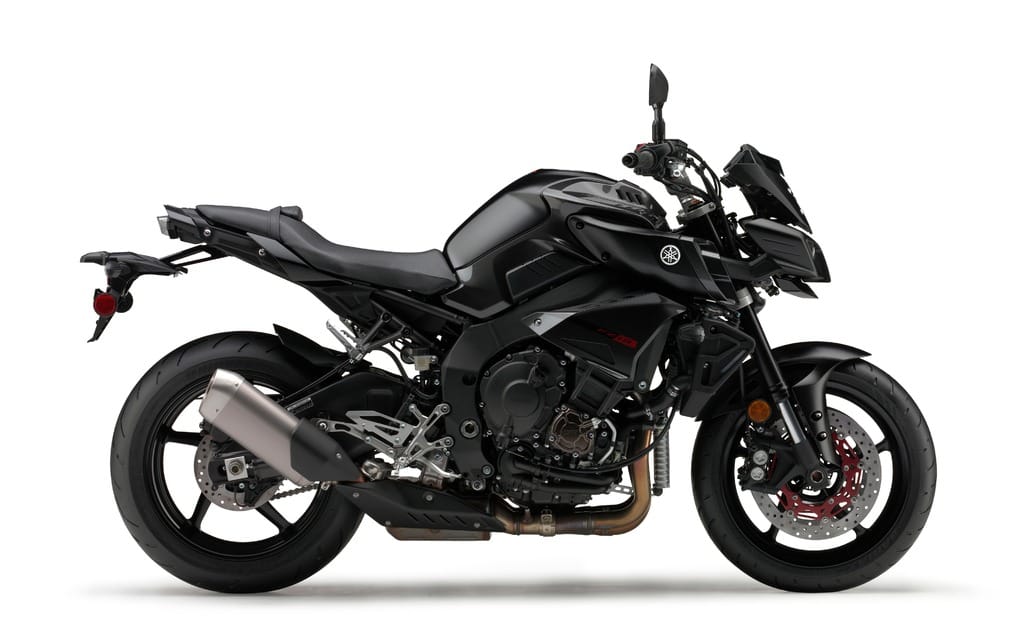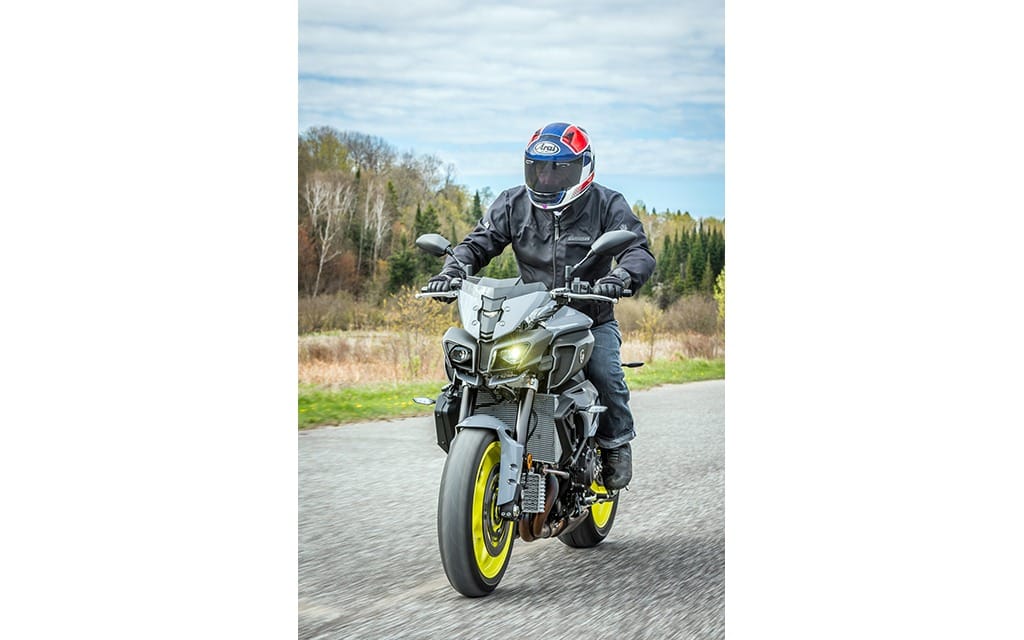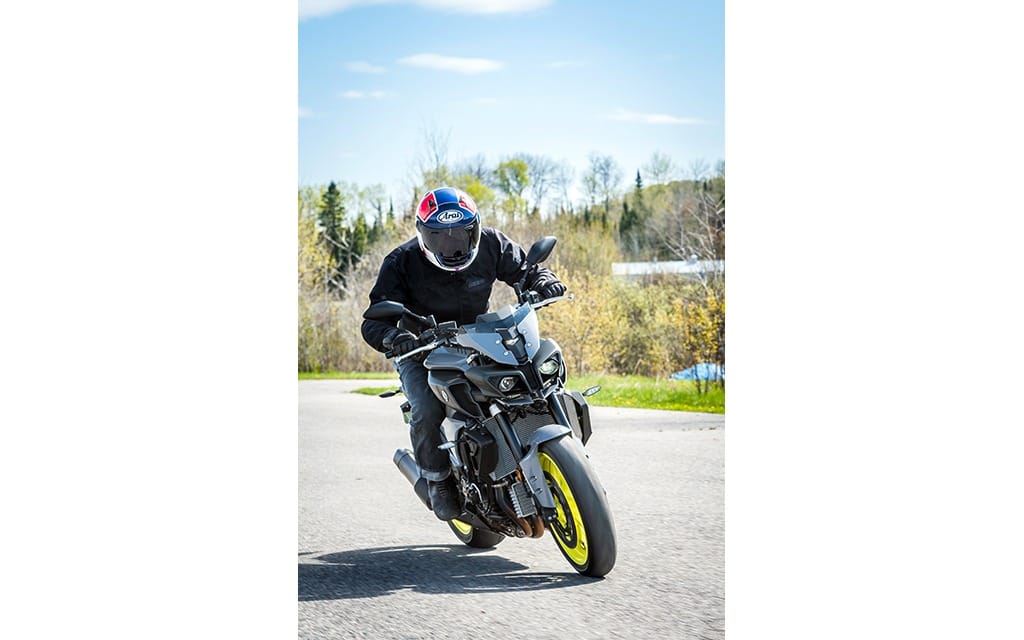Yamaha’s new high-perf standard is a rush, no matter what you think of its looks
The runway near Huntsville, Ontario, bore the weedy, dishevelled look of abandonment, but to my recollection no one from Yamaha Canada actually promised us that airplanes would not land on it while we practised a little clandestine dragstrip abuse. Still, none of the assembled journalists seemed worried about being dive-bombed by a wayward Cessna as, one after another, we turned up the throttle on an FZ-10, a YZF-R1S, an XSR900, and even an FJR1300 (with electric suspension adjustment, don’t you know) and held it that way until just before reaching the pedestrian-and-dog crossing area. Just to be clear, a Yamaha Canada guy did urge us not to run over any pedestrians, or even any dogs.
Suitably warned, we rolled off throttle and applied brake—often, just for the hell of it, hard enough to activate front ABS—in time to roll a 180 and head back down the strip to the swampy area where the other five testers waited near a clump of Yamahas and a photographer’s Volvo. It had been a while since I’d opened the throttle on a 150-plus-horsepower motorcycle, so before I tried out the R1S, I asked a techie to turn on the anti-wheelie function. But I wasn’t really there to test the R1S, I was there to try out the FZ-10, which in Europe is the MT-10, and which will become available in Canada around the time you read this.
“Why isn’t the FZ-10 in this group?” I asked Yamaha’s effervescent John Bayliss during an intro talk the previous day. The 2016 models were listed on a screen. He repeated my question, and then said, “Because it’s a 2017 model.”
The FZ-10 does not in my opinion appear to be a year ahead of its time—though it’s a little early to make that judgment. It does look thoroughly modern, though, and while I’d argue that it is stylistically a little too aggressive to be called attractive, Bayliss said its looks won’t likely hurt sales. The FZ-10, Bayliss said, “replaces the FZ-1” and is the flagship of the FZ line. The FZ-07 is a twin; the FZ-09 is a triple, and now the FZ-10 has the R1’s four-cylinder engine, complete with crossplane crank. Yamaha’s description is a little vague: “new roadster concept with extreme styling,” and Bayliss admitted there was concern that customers would not go for the alien-robot shapes of the FZ-10’s plastic, but he has found that it is “appealing to a wide range of people,” which really means a wide range of ages, and has been “well-accepted,” he said, “at least in shows.”
Like its looks or not, the FZ-10’s behaviour on that Huntsville airstrip and later on twisty roads in the region was thrilling.
“It wheelied in the first three gears,” I said after a surprisingly energetic runway shot. “Well, yeah,” someone replied, as if I shouldn’t have been surprised. “It’s got an R1 engine.” Indeed, it does, and while there are differences between this bike’s engine and an R1’s, there’s no mistaking that level of authority; it’s a very strong engine, and acceleration under full throttle is stimulating to the senses.
But power output in the range of the FZ-10 and the R1S can be a little confounding. Some riders might be able to feel more or less horsepower by the way a bike roars at full throttle, but it seems to me that the quantitative difference between bikes of a certain calibre—a fraction of a second on a quarter-mile strip or a few kilometres per hour in a race course straight—is not something an ordinary, or even a highly skilled, street rider is likely to appreciate. I took each bike, the FZ-10, the XSR900, the FJR1300, and the R1S, down that strip under full throttle, and though there is a significant difference in maximum output among those bikes, I could not, by the seat of my pants, say that any of them was slower or quicker than any other. They were all shockingly quick, so willing to rev and leap down that track that you hardly got going before you were braking for those mythical dog-walkers. Even the FJR. I rode that one to the drag strip (sorry, I mean the runway), and then, as the rider in front of me (I forget what he was on) opened his throttle, I opened mine, and the heavy, sport-touring FJR lost nothing that I could detect to the bike in front of it. Gearing, weight, torque output, and other factors influence the way a motorcycle feels under acceleration, but when several bikes are blindingly quick, it’s hard (for me, anyway) to separate one from another. Fast is fast.
The FZ-10’s four cylinder, 998 cc engine, for those who care, “makes about 160 horsepower,” Bayliss told us during our pre-ride briefing. He said it’s “retuned” from R1 specs (not detuned) for better midrange torque, and should be thought of as an R1S engine. Yamaha claims 82 lb-ft of torque for it at 9,000 rpm, which is a lot of twisting force for a relatively light (210 kg or 463 lb wet) motorcycle. (Yamaha claims 83 lb-ft for the R1S, but at 11,500.) Like the R1 and the R1S, the FZ-10 engine has a crossplane crankshaft, Yamaha’s chip-controlled throttle, and a slipper clutch, but the list of differences between this model’s engine and an R1 or R1S engine is considerable.
Camshafts, both intake and exhaust, have reduced lift and overlap. The intake port diameter in the combustion chamber is a little smaller. Intake valve diameters are down to 31 mm from 33, and both intake and exhaust valves are made of steel rather than the titanium used in the R1 and R1S valves. Piston crowns are flatter, which lowers compression from 13.5 to 12:1 (but doesn’t lower the need for high-octane gas), and the crossplane crank is heavier than the R1S’s (Bayliss: “So we have the lightest crank in the R1, we have the mid-step in the R1S, and we have the heaviest crank used in the FZ-10”) and the rotor weight is also increased—the heavier crank and rotor contributing to better low-end torque and acceleration. I can vouch that acceleration from a low speed on the FZ-10 is stirring.
The FZ-10’s throttle bodies have been changed, losing secondary injectors, and the airbox has been fattened to 12 litres from 10.5, which should promote smoother on-off throttle transitions. My experience later on the bike did not back up this claim, as I found it jerky in throttle transitions, though when I switched the power mode from Rowdy to Civilized (not Yamaha’s terms, but more on that later) a few hours later, I found no such jerky behaviour; it was probably my wrist, anyway, that was misbehaving, not the bike.
More changes from the R1 spectrum: the exhaust system on the FZ-10 does not open up an extra chamber below 7,000 rpm. Also, the engine covers and oil pan are aluminum, not magnesium.
Differences are more pronounced in the realm of electronic rider aids. The FZ-10 has cruise control, a feature that, ironically, might occasionally be more useful on an R1 or R1S, as anyone who has toured on a sport bike and suffered for it would know. (Bayliss, ever the scofflaw, was happy to note that the cruise control can be shut off by all normal means, but also by turning the throttle, which the cruise control leaves open just a bit, so a trailing police officer won’t see a sudden flash of red from the LED brake light as you depart from extra-legal speeds.) The FZ-10 also has traction control that operates in three modes and can be turned off, and it has Yamaha’s D-Mode power control system, which operates in Standard, A mode, and B mode. Unlike other Yamahas, A mode is a middle setting, more zippy than Standard (which I earlier called Civilized) and less so than B (Rowdy). This was all carefully explained by Bayliss around the meeting room table, but the next day, when I asked a Yamaha techie which mode was sportier, he became confused and gave me the wrong information (another techie interrupted to correct him), so this A for Allright but B for Badass setting is a switch for Yamaha, no pun intended.
Unlike the R1 series, the FZ-10 has, according to Bayliss, “no launch control, lift control, slide control, or quick shift,” because it does not have an IMU (Internal Measuring Unit). A quick shift can be fitted as an accessory. As I learned on that airstrip, the absence of lift control is quite noticeable under full throttle, though the wheelies I experienced were minor things.
The FZ-10 shares a number of chassis components with the R1, including a fully adjustable 43 mm inverted KYB fork, an electronic steering damper, and full LED lighting, but unlike the R1, the ABS brakes (four-piston monobloc in front, the usual single-piston affair behind) are not linked. Wheels are five-spoke aluminum hoops, similar to the R1S but not the R1, and the seat is a single piece, unlike the two-piece perches of the R1 family. The handlebar is aluminum and, of course, puts the controls much higher than on a pure sports bike like the R1.
There are other differences: the battery output is higher on the FZ-10, the wheelbase is, surprisingly, five mm shorter, and of course the weight is a little more.
The single most important difference, though, is in rider comfort. The FZ-10 is, like the FZ-1 before it, a very comfortable motorcycle—comfy enough to ride across the country if you want. The hands fall at a natural angle, the knees are bent just slightly less than (tighter than) 90 degrees, and the footpegs are lower than you might expect (when I first sat on it, I had come off a sport bike, and I couldn’t find the pegs—they were just so much lower than I expected) but not so low as to interfere with cornering. I found the seat a little off-putting; its shape is a bit winged, which causes the rider to feel a hump under each thigh, as if someone had sealed a tennis ball into the seat—but soon enough, especially when the roads around Huntsville became twisty and entertaining, this feature felt normal.
Yamaha Canada trucked at least a couple of each model to the Deerhurst Resort outside Huntsville, so on group rides, we were able to switch, and I found myself on the XSR a couple of times. In the twisties, this 15-kilo lighter triple felt a little quicker in side-to-side transitions, no less comfortable, and not, to me, noticeable slower. But when I stepped back onto the FZ-10 I also didn’t notice any penalty for the extra weight. It was a case of loving the one you’re with, really. Aboard the XSR, I liked it best; then, back on the FZ-10, I liked it best. Maybe I’m just fickle, but when the FZ-10 rips through the gears, sounding provocatively like a high-performance twin and accelerating in that furious rush, it’s a very convincing motorcycle. Again and again, I found myself thinking, I could live with this.
Two colours, bluish grey for $15,799, and grey-and-black, $15,499. Get yours while they last.
